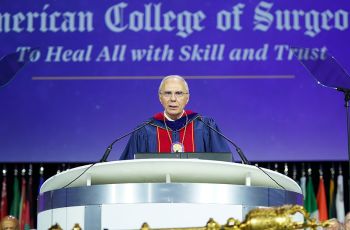Driving at night can take on an otherworldly look: starbursts and glare from headlights, vanishing lines on streets, hard-to-read signs and signals. Night blindness, which occurs when people have trouble seeing in dim light, can have many causes – but also many solutions. Keith Wroblewski, MD, associate professor of ophthalmology at the George Washington University (GW) Medical Faculty Associates, takes us through the whys of night blindness and how to treat it.
What is night blindness? What causes it?
Wroblewski: Night blindness is due to the fact that in dim conditions, the pupil dilates more to bring in more light for the retina. What happens is a geometric issue; the peripheral rays of light hit the lens, and those ray-tracings, so to speak, cause folks who are slightly myopic, or nearsighted, to have more myopia or more near-vision problems. As a result, people who are nearsighted end up having a change in their prescription and don’t see as well at night.
There are [genetic] conditions where people don’t see well at night, such as congenital stationary night blindness. We have rods and cones [in our eyes]; the cones give us color vision, and our color vision is what gives us our best central visual acuity. Those are in our central vision, where macular degeneration hits. To see at night, our vision is based on our rods. If we talk about an owl eye, it has very acute vision, and particularly at night, because they have a lot of rods and it’s purported that they don’t have very many cones, if any at all.
Why are some people more prone to night blindness than others?
Wroblewski: One of the problems [that affects more than just near-sighted people or those with a genetic condition] is the design of car headlights. They’ve moved from regular, incandescent lights to halogen lights, and now we’re onto xenon lights, which are terribly bright. Those lights cause a lot of scatter and starburst-like effects when people drive at night. In particular, when patients have early cataracts, those [effects] can be very disconcerting, and they can experience these difficulties earlier. Folks who might have had LASIK can also have glare and halos at night due to the residual effects of the procedure.
What are the treatments for night blindness?
Wroblewski: First off, [we] make sure that the patient has an adequate correction, that their prescription is not under-corrected. When people have to drive a lot at night, we would recommend a prescription that is slightly more myopic, about a half diopter more myopic than what they would use during daylight hours. There are also medicines that we sometimes give to keep the pupil constricted. One of these is called Brimonidine, the same medicine we use in post-LASIK or post-refractive surgery patients when they have a lot of glare and halos at night. We use that to constrict the pupils so that they don’t dilate as well as normal pupils, and that can be very effective.
Is night blindness ever a sign of a more serious diagnosis?
Wroblewski: There’s a technical term for night blindness known as nyctalopia, and it is often an early sign of vitamin A deficiency. Vitamin A deficiency occurs after measles, but also can occur in inflammatory bowel diseases, such as celiac sprue, or in folks who have had gastric resections for weight loss or weight-reduction therapies.
Can patients do anything to prevent night blindness?
Wroblewski: At night, I just tell patients to make sure that they focus on the white line on the right side of the road. For patients who have early cataracts, particularly cortical cataracts, I recommend early cataract surgery. Also, as a result or as part of a full workup for LASIK or refractive surgery, the pupil size is measured in both light and dark conditions. Patients who have a high baseline or a high pupillary diameter have a higher risk of nighttime abnormalities. This also comes to play in patients who decide to purchase an upgrade with a standard cataract surgery with some of the newer-fangled multifocal lenses, such as the Johnson and Johnson synergy lens, the Alcon Vivity lens, or the Alcon PanOptix lenses. These lenses are based by design on a series of concentric circles, and patients who get these lenses may have more glare, starburst, or dazzle-like effects as a result of the lens design. They can also have a loss of what we call “contrast sensitivity,” which is the ability to determine depth, shadowing, and some other technical visual issues in dim illumination.
How does GW care for patients who might have night blindness or other issues with their sight?
Wroblewski: What we want to first do is make sure that there is not another condition such as albinism or anything wrong with the retina, so we do a thorough retinal exam, sometimes including optical coherence tomography and optos fundus imaging. That can be performed by either the comprehensive staff, our optometrist, Geneva Cleveland, OD, or the uveitis staff, which is Monica Dalal, MD, and I. We also prescribe many medicines that may or may not help in these cases.
To make an appointment with an ophthalmologist, visit the GW MFA Department of Ophthalmology or call 202-741-2800.




